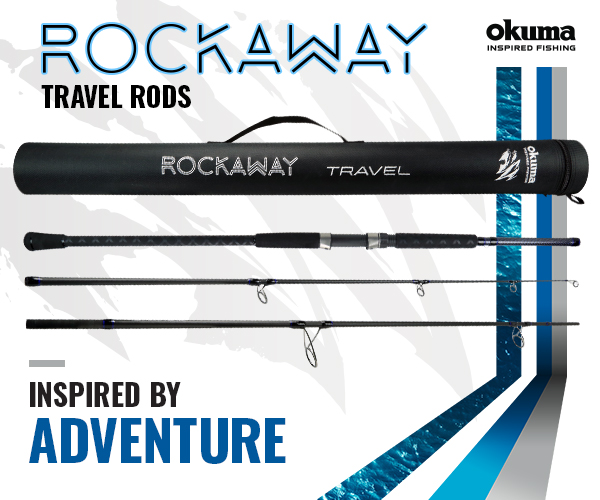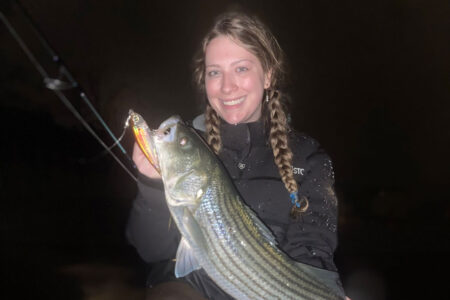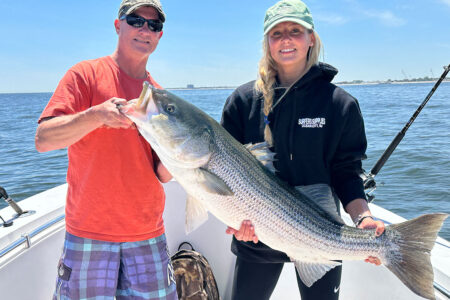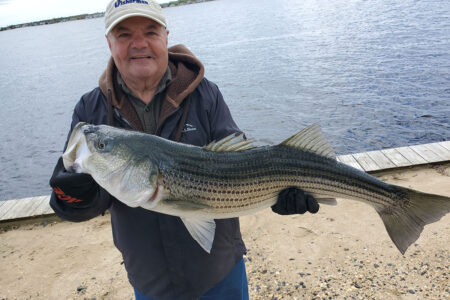The striped bass population is alive and well many miles north of the proverbial “Striper Coast”
Fishing provides great therapy and is an element crucial to the wellness of anglers who immerse themselves in the sport. That’s why when people call the Fisherman office to renew their “prescriptions,” they are never corrected. And while I no longer fish at the frantic pace I once did, I’m still learning and keeping pace every day – reading every article we publish; seeing, sharing and posting catch photos on social media; and watching fishing video after fishing video. The passion is still there and I can relate to never wanting to leave the water. I understand the drive to go again as soon as you reach home. I get all the effort that goes into the planning and execution of every trip, even if only to sneak away for a tide. There’s something so dear to me that my daily life is basically one big hustle to get back to it. My version of “going fishing” is “heading north,” to Nova Scotia. When it came time to assign an article on striper fishing at their northern range, there wasn’t a question of who should write it, since once I start talking Canada, I don’t shut up about it.
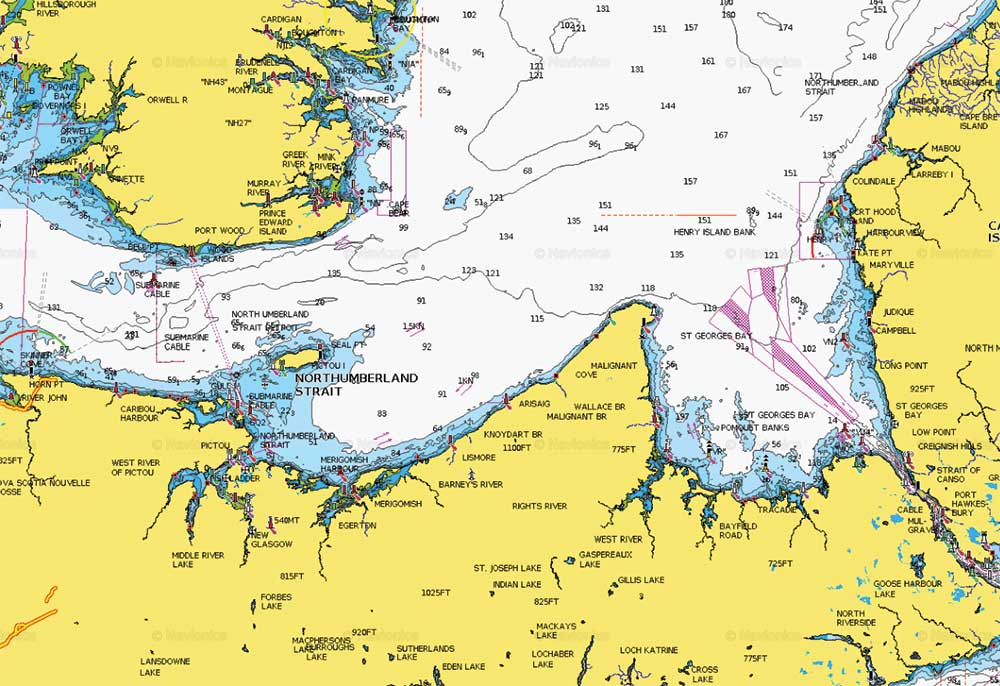
Similar to many anglers’ first catches, my connection to Canada started in childhood. It took me almost 40 years to make it to FL, however I remember attending a family reunion up there at 4. My kid was nine months old the first time she went north—got to start them young. When I set out to answer a few fishing questions like: What is the state of striper fishing in the Canadian Maritimes and is global climate change altering the migration and steering our fish up there? My initial sources were the cousins and uncles with whom I’ve fly fished for trout in river pools behind the family mill.
Stripers Have Stripes
After phone calls to the 902 area code, engrossed in my favorite accent in the world, I learned that much of the state of the striper fishery is similar to that in the U.S. Fishing for striped bass has enamored Canadian anglers for generations. They can be caught from early spring to late fall and from time to time through the ice. Although we didn’t run the numbers, it is understood that the species has great economic value to the region, some even claiming it to be more valuable now than the salmon sport fishery. Conservation efforts have been in place after a late ‘90s Gulf spawning stock crash and rebuild, including a once-closed commercial fishery and current single-hook catch and release recreational season and a 3-fish bag and slot limit regulation.
Like us, our neighbors to the north have more questions than answers regarding striped bass. Researchers at Acadia University in Wolfville, NS and the University of New Brunswick in Saint John, NB have been studying striper characteristics along with community partners in the hopes of understanding the species better. There are current studies and tagging programs focusing on the mixing rate of Canadian and US stripers in the Bay of Fundy and attempts to distinguish the DNA of each population; closing the knowledge gap of overwintering populations of Cape Breton Island and other northern reaches of the species; and defining to what degree of predation the population boom of spawning stripers is affecting salmon smolt. Some of what’s understood at this point is based on anecdotal evidence of recreational anglers—some of who provided me with information.
Bay of Fun-dy Fishing
By far the most exciting and unique striper fishing phenomenon Nova Scotia offers is the tidal bore fishing of the Stewiacke and Shubenacadie rivers. The Bay of Fundy, located between the provinces of New Brunswick and Nova Scotia, has an extreme tidal range and the highest tides on the planet. Since the bay tides are so strong, tidal rivers can be temporarily reversed, causing a crest of water to form as the water heads against its normal flow–a tidal bore. During the early spring as stripers head into the rivers to spawn, this geological feature plays a role in striper fishing.
According to Matt Szeto of Fish On! Guide Service, “I’ve seen the water merely change direction and start filling up the river on the lower tides, and on higher tides I’ve seen it rush in as a 3-foot wall of water. Bores can be so strong they will carry 50-foot trees down river.” Matt mentioned that twice a day the tidal bore enters the river with all the stripers right behind it. “Depending on how high the tide, it can push fish more than 6 km up river.” He says at times it’s almost impossible to fish with such strong currents and debris in the water and he just waits for about 30 minutes for the situation to settle down before fishing again.
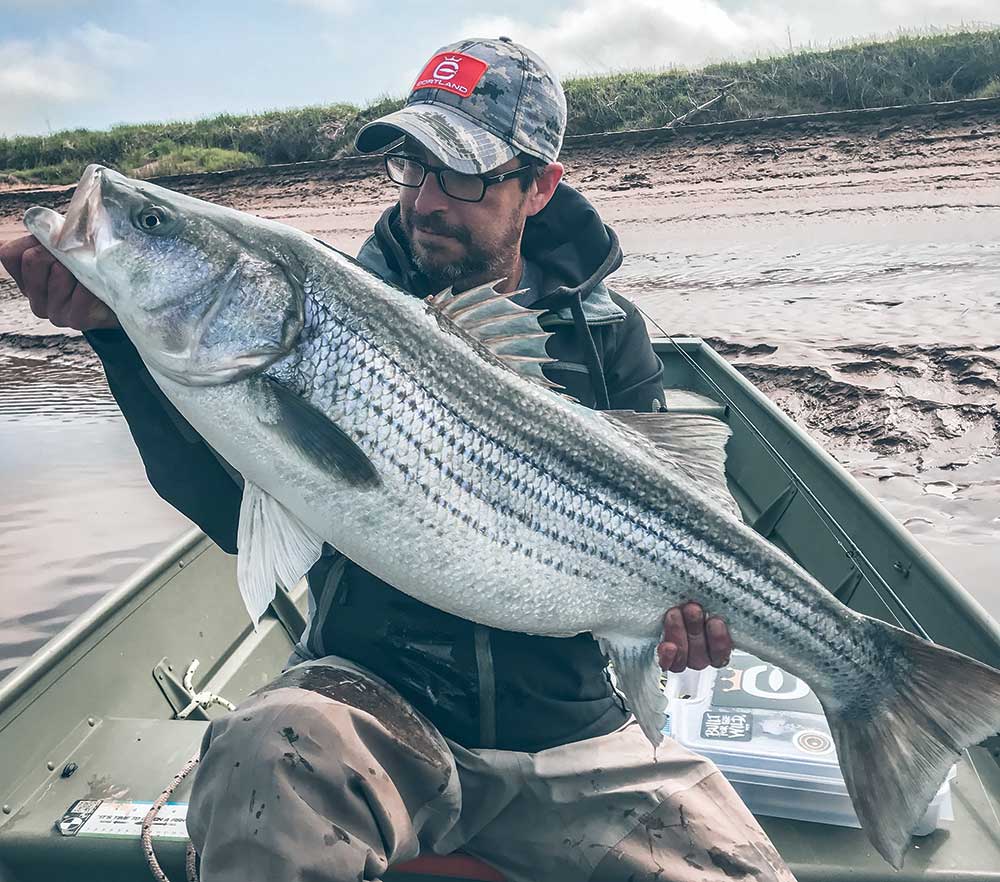
fishing the Stewiacke River tidal bore. Photo by Matt Szeto
It’s single-hook, catch and release only during the tidal bores, from May 10 to June 10 to protect spawning stripers. Szeto said, “I have seen a kilometer long stretch of river just boil from bank to bank with 30-plus inch fish spawning.” The image reminded me of the “mile-long” blitzes I used to see around Long Island, NY in the fall.
Water clarity is a major factor in tackle selection when fishing these tidal rivers. Matt uses heavy action rods and spools his reels with 30- to 40-pound braid on his size 4000 to 6000 reels and doesn’t bother with fluorocarbon leaders due to low visibility. They fish Danny surface swimmers when the fish show on top and swim shads and large curly tail grubs to over 6 inches when they don’t. “Rig the curly tails on a 1- to 2-ounce jig head and fire away.” Everything is fished slowly to give the fish the chance to see the lure. The favorite color is chartreuse. “If I find myself foul hooking a lot of fish I will swap the jig head out for a 4/0 to 5/0 wide gap hook and bullet weight and rig it Texas style.”
Tim Myers, of Myers Media, whose stunning fish photos have interrupted my Insta-scrolling time and again, has been fly fishing for stripers in the Stewiacke River for about 20 years. He says the fishing has always been good since he started and interest is only growing. Stripers start heading into the river when the water reaches the low 50s, with spawning starting at 60. Myers says you can catch big fish at that time, but the magic water temperature of 56 degrees is when the furious action starts. He fishes gaspereau (alewife) patterns early in the season and shad ones when the water warms up. From the end of May to early June, when the Stewiacke River is “a Jacuzzi of spawning fish” he fishes the bore and the outgoing tide with hand-tied Deceivers and Clousers in sizes 1/0 to 3/0. Although he only fishes with fly gear, with a personal best fatty caught on a 10-weight, he says Truro is the hotspot for conventional tackle. He warns that it’s crowded, and there are many other spots to surf fish away from the crowds, like Minas Basin. Having stood shoulder to shoulder in Montauk fall runs and experienced “traffic” in Halifax on Hwy 102, I feel compelled to see how crowded is crowded.
Myers Media recently shot a short film with Matt Szeto called BORE, showing off this Nova Scotia fishing phenomenon. So far only the official teaser has been released, but after learning all of this and seeing the trailer, I can’t wait for the full release. It and my next trip to Nova Scotia are coming in 2020.
Cape Breton Island
Drive north along the eastern coast of the U.S., cross the border at Calais, ME, keep on driving through New Brunswick (Sussex or Moncton are typical spots for an overnight stop for Long Islanders.) and straight on through Nova Scotia, and you will eventually reach the Canso Causeway. The crossing welcomes you to Cape Breton Island, well known for Cape Breton Highlands National Park and the Cabot Trail. I use the bridge welcome as a photo opp. to alert family members waiting for me inland to put the beer on ice and to gloat to others that didn’t make the trip with me–much like some anglers do when their friends miss the bite.
I cross and head towards Port Hawkesbury, whose pulp mill supplied the paper to print The Fisherman Magazine through the early 2000s, but fishermen may go the opposite direction to meet up with A Great Day Fishing Guide Service’s Conor Demone. He’s the new addition to the team of Jim Logan and Jimmie Pedersen, who specialize in guiding fly fishermen for the world-class wild Atlantic salmon fishing on the Margaree, Cheticamp and Middle rivers. Demone is heading up the striper guiding division in 2020 fishing ocean stripers in the Northumberland Strait, Margaree Harbor and the tidal rivers.
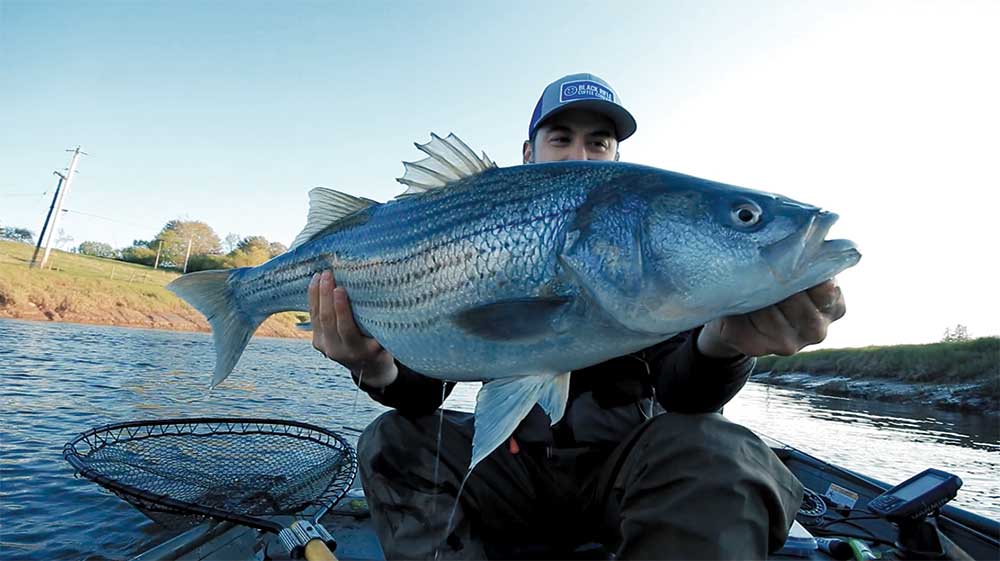
Regarding striper fishing in Nova Scotia, Demone says there’s always been stripers in the area; his family fished them as early as the ‘50s and ‘60s. Fish populations fluctuate year to year, similar to ours here in the U.S. Interest in the recreational fishery is only increasing. He says even his salmon clients are drawn to the great angling opportunity it provides when they switch to fishing for stripers in the heat of July and August to give the salmon a break. Many use hollow eye flies oftentimes catching brown trout as bycatch and never seeing another angler in the wide open and untouched landscape of Nova Scotia. With no one looking, there’s no better place to practice flycasts if you ask me.
Another angler whose Insta posts stopped my scroll was Skyler Jeddore. While his dedication to fishing is proven by an array of locations and seasons fished, methods used, and species caught, one of his running posts grabbed me initially; he jogs along the road that leads to my family’s old farmland. Holding my attention are catches like his first of 2020, a monster 8-pound fly-caught rainbow trout, hooked in the same estuary I peacefully float in during summer trips.
Jeddore says that the striper fishing season for the Maritimes region of Cape Breton Island, from Cape North to Port Hawkesbury, is all year for coastal and tidal waters, with fishing picking up in late July and getting progressively better until mid-November. The beaches he fishes most are very rocky, and one of his favorites has a reef about 75 yards out and stretches around a cape. They look to fish the trough between the shore and the reef where stripers come in to feed on bait. “In the summer months I find the best way to get striped bass is to use live or chunked bait such as mackerel or capelin. The gear we use in the summer would be a stiff 12-foot surfcasting rod rated to 10 ounces and a 6-ounce pyramid sinker and fish-finder rig with a circle hook tipped with fresh chunk of mackerel.”
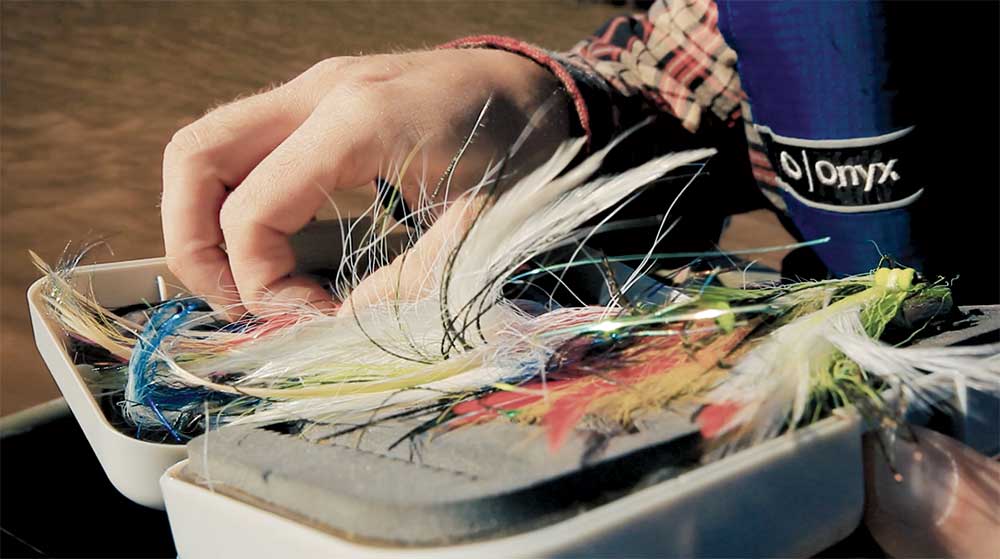
early in the season and shad ones when the water warms up.
His favorite conditions to target Cape Breton stripers are during a storm front or new moon with high tide hitting at night. It’s suspected that migrations are tighter for Maritime stripers, however there is a fall run in October when the water temperatures start to drop. Sand eels and bay pollock close to shore warrant the use of plugs and top water poppers, with SP minnows, Super Strike darters and Tsunami sand eels local favorites. “We always had the best luck from then and into mid-November.” Notable Jeddore striper catches include a 50-pounder a few years ago, an October 43-pounder caught and released on a Super Strike darter, and a 25-pounder taken on a Tsunami sand eel.
For years now, my uncle, who lives in the same county as Jeddore, has heard reports of springtime 50 and 60 pounders, and while I’ve visited in the summer and winter, I’ve yet to make the pilgrimage in June. Maybe this is the year I head north to see for myself. Who wants to go?
| Guide Contact Info |
|---|
|
Matt Szeto, Fish On! Guide Service Conor Demone, A Great Day Fishing Guide Service Tim Myers, Myers Media Skyler Jeddore |
